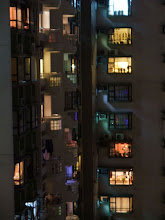As Cities grow the communal culture once noticed amongst villages diminishes. We who live so close to each other are yet so distant. Neighbors act like strangers, but on a strange occasion: only when we need the help of another, we bother to become acquainted (so to speak). Least the experience of living in a 37 floored building with 2 apts on each floor has proven. Had I not know of the two students from my same school living in the same building, I would have not known anyone in the building. Why is this so?
In the village conditions, despite distance amongst families their dependency and reliance on each other is so great that everyone knows of each others business. Where as here those living one above another are so disassociated with each other, that they become strangers. (is this considered a part of a urban decay?...)
...the lost of public space is related to the loss of public life because introverted private lives have eclipsed both...(such in The Fall of Public Man by Richard Sennett)
As we become closer to one another, we may become more estranged. The advancement of technology has strangely brought those separated by the pacific to be closer that those living next door to each other...
...the again as architects design buildings to accommodate everything, "life" (as we call it) moves inwards (cinemas, theaters, schools, museums, aquariums, gymnasiums, swimming pools...), outdoor life is left behind. It is as if that as we become more technology dependent, we trade in the "nature" condition for one that we can control...(power!)
...as proven by the increase of residents in cities therefore the diminishing villages and their cultures. young people from the rural villages are leaving their home and moving to the cities where they can earn more money...leaving a farmers life behind and moving to work in front of computers or (more like) inwards...
(on a separate note: when the younger generation leave the rural villages, they are also endangering that particular culture of their region. the elders stay behind awaiting for the return of their children, but of course many choose the better life which they have found in cities. Few ever return to their past lives. As they say Until you have gained knowledge of what else is out there, the world is as (informed as)you know it. )
oh going back to say that ... as we move our lives inwards, the public spaces become buildings. therefore there is a lack of public outdoor spaces, or the usage of these spaces. the usage of parks though seem high in demand become less used. (IF The city's population density of 26,403 people per square mile (10,194/km²) and Central park is 843 acres or 1.32 sq mi (3.4 km2), According to that calculation, Central park can only occupy 34852 people (so to speak). So imagine if even 5% of Manhattan residents actually all went/used to Central Park ...it'd be like the amount of people gathering to watch the new years countdown in Times Sq) So there is a need to generate more public spaces, but more importantly, a purpose is needed to bring people to the outdoors. Some sort of attraction that brings life back to the outside.
Another example would be the podiums that we have here in HK. Every estate/ tall buildings, has some sort of outdoor garden that serves to divide the residential from the parking garages or commercial area. So instead of having a blank roof, a podium - acting as a type of "green roof", as well as "garden", is created. But really if i were to count the number of people who use that space, theres just a handful compared to the amount of residents in the estate.
The Elderlies do their morning workouts, then during the day the maids bring the children to play (thats if there is no school). Some people jog (but then it gets boring since its quite small) others walk around in circles for fresh air and a bit of exercise. ( come to think of it, with everyone upstairs in the apartments able to look down and 'watch' you, its kind of like a prison/ zoo. )
So other than these brief activities, there has to be a larger force, motivation/ attraction to bring people together. To create a proper community as in the villages, a place of interaction to diminish the amount of ongoing seclusion.
Wednesday, December 31, 2008
seclusion
Labels:
Public Space,
Thesis Research
Subscribe to:
Post Comments (Atom)

No comments:
Post a Comment